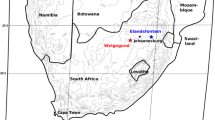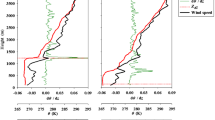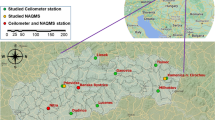Abstract
The determination of the depth of daytime and nighttime mixing layers must be known very accurately to relate boundary-layer concentrations of gases or particles to upstream fluxes. The mixing-height is parametrized in numerical weather prediction models, so improving the determination of the mixing height will improve the quality of the estimated gas and particle budgets. Datasets of mixing-height diurnal cycles with high temporal and spatial resolutions are sought by various end users. Lidars and ceilometers provide vertical profiles of backscatter from aerosol particles. As aerosols are predominantly concentrated in the mixing layer, lidar backscatter profiles can be used to trace the depth of the mixing layer. Large numbers of automatic profiling lidars and ceilometers are deployed by meteorological services and other agencies in several European countries providing systems to monitor the mixing height on temporal and spatial scales of unprecedented density. We investigate limitations and capabilities of existing mixing height retrieval algorithms by applying five different retrieval techniques to three different lidars and ceilometers deployed during two 1-month campaigns. We studied three important steps in the mixing height retrieval process, namely the lidar/ceilometer pre-processing to reach sufficient signal-to-noise ratio, gradient detection techniques to find the significant aerosol gradients, and finally quality control and layer attribution to identify the actual mixing height from multiple possible layer detections. We found that layer attribution is by far the most uncertain step. We tested different gradient detection techniques, and found no evidence that the first derivative, wavelet transform, and two-dimensional derivative techniques have different skills to detect one or multiple significant aerosol gradients from lidar and ceilometer attenuated backscatter. However, our study shows that, when mixing height retrievals from a ultraviolet lidar and a near-infrared ceilometer agreed, they were 25–40% more likely to agree with an independent radiosonde mixing height retrieval than when each lidar or ceilometer was used alone. Furthermore, we point to directions that may assist the layer attribution step, for instance using commonly available surface measurements of radiation and temperature to derive surface sensible heat fluxes as a proxy for the intensity of convective mixing. It is a worthwhile effort to pursue such studies so that within a few years automatic profiling lidar and ceilometer networks can be utilized efficiently to monitor mixing heights at the European scale.
Similar content being viewed by others
References
Angelini F, Barnaba F, Landi TC, Caporaso L, Gobbi GP (2009) Study of atmospheric aerosols and mixing layer by LIDAR. Radiat Prot Dosim 137: 275–279
Baars H, Ansmann A, Engelmann R, Althausen D (2008) Continuous monitoring of the boundary-layer top with lidar. Atmos Chem Phys 8: 7281–7296
Batchvarova E, Gryning S (1991) Applied model for the growth of the daytime mixed layer. Boundary-Layer Meteorol 56: 261–274
Blackadar KA (1979) High-resolution models of the planetary boundary layer. In: Pfaffin JR, Ziegler EN (eds) Advances in environmental science and engineering, vol 1. Gordon and Breech Science Publishers, Inc, New York, pp 50–85
Brooks IM (2003) Finding boundary layer top: application of a wavelet covariance transform to lidar backscatter profiles. J Atmos Ocean Technol 20: 1092–1105
Ciaramella, A, Riccio A, Angelini F, Gobbi GP, Landi T (2009) Statistical and fuzzy approaches for atmospheric boundary layer classification AI*IA 2009: emergent perspectives in artificial intelligence, vol 5883 of lecture notes in computer science. Springer, Berlin, pp 375–384. http://dx.doi.org/101007/978-3-642-10291-2_38
Canny J (1986) A computational approach to edge detection. IEEE Trans Pattern Anal Mach Intell (PAMI) 8: 679–698
Cohn SA, Angevine WM (2000) Boundary layer height and entrainment zone thickness measured by lidars and wind-profiling radars. J Appl Meteorol 39: 1233–1247
Emeis S, Schäfer K (2006) Remote sensing methods to investigate boundary-layer structures relevant to air pollution in cities. Boundary-Layer Meteorol 121: 377–385
Emeis S, Schäfer K, Münkel C (2008) Surface-based remote sensing of the mixing-layer height: a review. Meteorol Z 17: 621–630
Eresmaa N, Karppinen A, Joffre SM, Räsänen J, Talvitie H (2006) Mixing height determination by ceilometer. Atmos Chem Phys 6: 1485–1493
Flamant C, Pelon J, Flamant PH, Durand P (1997) Lidar determination of the entrainment zone thickness at the top of the unstable marine atmospheric boundary layer. Boundary-Layer Meteorol 83: 247–284
Flentje H, Heese B, Reichardt J, Thomas W (2010) Aerosol profiling using the ceilometer network of the German Meteorological Service. Atmos Meas Tech Discuss 3: 3643–3673. doi:10.5194/amtd-3-3643-2010
Gerbig C, Körner S, Lin JC (2008) Vertical mixing in atmospheric tracer transport models: error characterization and propagation. Atmos Chem Phys 8: 591–602
Haeffelin M, Barthes L, Bock O, Boitel C, Bony S, Bouniol D, Chepfer H, Chiriaco M, Cuesta J, Delanoe J, Drobinski P, Dufresne JL, Flamant C, Grall M, Hodzic A, Hourdin F, Lapouge F, Lemaitre Y, Mathieu A, Morille Y, Naud C, Noel V, O’Hirok W, Pelon J, Pietras C, Protat A, Romand B, Scialom G, Vautard R (2005) SIRTA, a ground-based atmospheric observatory for cloud and aerosol research. Ann Geophys 23: 253–275
Haij MJD, Klein Baltink H (2007) Continuous mixing layer height determination using the LD-40 ceilometer: a feasibility study KNMI. Scientific Report WR
Hennemuth B, Lammert A (2006) Determination of the atmospheric boundary layer height from radiosonde and lidar backscatter. Boundary-Layer Meteorol 120: 181–200
Holzworth GC (1967) Mixing depths, wind speeds and air pollution potential for selected locations in the United States. J Appl Meteorol 6:1039–1044
Hooper WP, Eloranta EW (1986) Lidar measurements of wind in the planetary boundary layer: the method, accuracy and results from joint measurements with radiosonde and kytoon. J Clim Appl Meteorol 25: 990–1001
Lammert A, Bösenberg J (2006) Determination of the convective boundary layer height with laser remote sensing. Boundary-Layer Meteorol 119: 159–170
Martucci G, Matthey R, Mitev V, Richner H (2007) Comparison between backscatter lidar and radiosonde measurements of the diurnal and nocturnal stratification in the lower troposphere. J Atmos Ocean Technol 24: 1231–1244
Martucci G, Milroy C, O’Dowd CD (2010a) Detection of cloud-base height using Jenoptik CHM15K and Vaisala CL31 ceilometers. J Atmos Ocean Technol 2: 305–318
Martucci G, Matthey R, Mitev V, Richner H (2010b) Frequency of boundary-layer-top fluctuations in convective and stable conditions using laser remote sensing. Boundary-Layer Meteorol 135: 313–331
Menut L, Flamant C, Pelon J, Flamant PH (1999) Urban boundary-layer height determination from lidar measurements over the Paris area. Appl Opt 38: 945–954
Monks P, Granier C, Fuzzi S, Stohl A, Williams M, Akimoto H, Amann M, Baklanov A, Baltensperger U, Bey I, Blake N, Blake R, Carslaw K, Cooper O, Dentener F, Fowler D, Fragkou E, Frost G, Generoso S, Ginoux P, Grewe V, Guenther A, Hansson H, Henne S, Hjorth J, Hofzumahaus A, Huntrieser H, Isaksen I, Jenkin M, Kaiser J, Kanakidou M, Klimont Z, Kulmala M, Laj P, Lawrence M, Lee J, Liousse C, Maione M, McFiggans G, Metzger A, Mieville A, Moussiopoulos N, Orlando J, O’Dowd C, Palmer P, Parrish D, Petzold A, Platt U, Pöschl U, Prévôt A, Reeves C, Reimann S, Rudich Y, Sellegri K, Steinbrecher R, Simpson D, ten Brink H, Theloke J, van der Werf G, Vautard R, Vestreng V, Vlachokostas C, von Glasow R (2009) Atmospheric composition change: global and regional air quality. Atmos Environ 43: 5268–5350
Morille Y, Haeffelin M, Drobinski P, Pelon J (2007) STRAT: an automated algorithm to retrieve the vertical structure of the atmosphere from single-channel lidar data. J Atmos Ocean Technol 24: 761–775
Münkel C, Eresmaa N, Räsänen J, Karppinene A (2007) Retrieval of mixing height and dust concentration with lidar ceilometer. Boundary-Layer Meteorol 124: 117–128
Pearson G, Davies F, Collier C (2010) Remote sensing of the tropical rain forest boundary layer using pulsed Doppler lidar. Atmos Chem Phys 10: 5891–5901
Seibert P, Beyrich F, Gryning S, Joffre S, Rasmussen A, Tercier P (2000) Review and intercomparison of operational methods for the determination of the mixing height. Atmos Environ 34: 1001–1027
Sicard M, Pérez C, Rocadenbosch F, Baldasano JM, García-Vizcaino D (2006) Mixed-layer depth determination in the barcelona coastal area from regular lidar measurements: methods, results and limitations. Boundary-Layer Meteorol 119: 135–157
Sobel I, Feldman G (2008) A 3 × 3 isotropic gradient operator for image processing presentation for stanford artificial project
Steyn DG, Baldi M, Hoff RM (1999) The detection of mixed layer depth and entrainment zone thickness from lidar backscatter profiles. J Atmos Ocean Technol 16: 953–959
Stull R (1988) An introduction to boundary layer meteorology. Kluwer, Dordrecht, 666 pp
Tennekes H (1973) A model for the dynamics of the inversion above a convective boundary layer. J Atmos Sci 30: 558–567
White JM, Bowers JF, Hanna SR, Lundquist JK (2009) Importance of using observations of mixing depths in order to avoid large prediction errors by a transport and dispersion model. J Atmos Ocean Technol 26: 22–32
Author information
Authors and Affiliations
Corresponding author
Rights and permissions
About this article
Cite this article
Haeffelin, M., Angelini, F., Morille, Y. et al. Evaluation of Mixing-Height Retrievals from Automatic Profiling Lidars and Ceilometers in View of Future Integrated Networks in Europe. Boundary-Layer Meteorol 143, 49–75 (2012). https://doi.org/10.1007/s10546-011-9643-z
Received:
Accepted:
Published:
Issue Date:
DOI: https://doi.org/10.1007/s10546-011-9643-z




